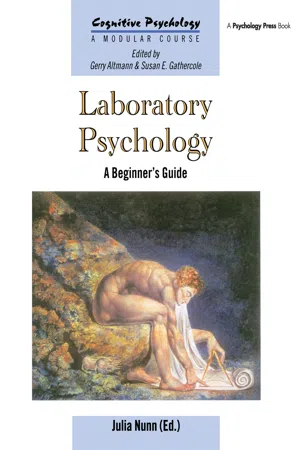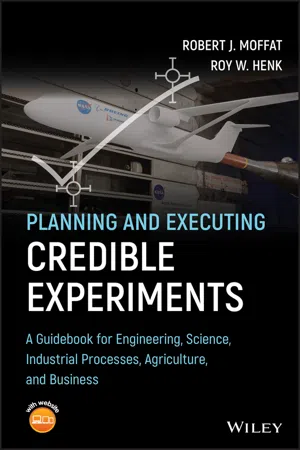Physics
Writing a Lab Report
A lab report in physics typically includes sections such as an introduction, methods, results, and discussion. The introduction provides background information and states the purpose of the experiment, while the methods section details the procedures and equipment used. The results section presents the data collected, and the discussion interprets the results and explores their implications.
Written by Perlego with AI-assistance
Related key terms
Related key terms
1 of 4
Related key terms
1 of 3
6 Key excerpts on "Writing a Lab Report"
- eBook - ePub
- Matthew French(Author)
- 2016(Publication Date)
- Mercury Learning and Information(Publisher)
• Take care to record the full filenames and locations of any data files stored on computer which need to be analyzed at a later date. Often these will take the form of a name followed by sequential numbers. For instance mydata.000, mydata.001, mydata.002, or mydata000.txt, mydata001.txt, mydata002.txt. Remember to make a copy on a memory stick or email a copy before leaving the lab.5.2 REPORTSAs well as keeping a neat lab book showing all the results and analysis of each experiment, students will often be required to write up two or three experiments formally as though they were scientific articles. This is a vital part of becoming a good Physicist, as once a cutting edge experiment is completed, the results analyzed and a new discovery has potentially been made the results need to be communicated with other Physicists. This has traditionally been achieved by writing the experiment up as a scientific paper and then submitting it to a scientific journal. The journal then ask a number of other Physicists (the identities of whom are unknown the the authors) working in similar fields at other universities or research laboratories to be a referee for the paper and to make critical comments upon the work. Referee comments are passed back to the authors for their comment or so that they make modifications to their paper. Based upon these comments the journal editors will make a decision to accept or reject the paper for publication.The aim of writing formal reports is to develop skills in writing papers: these will be vital in a future career in academia and almost certainly useful for a future career in any other field. They provide a good opportunity to gain a deeper understanding of an experiment beyond that achieved in a one or two day laboratory session.This section gives an overview of the typical structure of a formal written report and provides some advice on how to include references and write a report on a computer.5.2.1 SOFTWARESimple reports with a small number of equations, figures, and references can be most simply written in Microsoft Word, OpenOffice Writer, or an equivalent computer program. These programs are convenient since they immediately reflect changes made to formatting and content of the report, making it easy to see how the report will appear when printed. However, numbering and referring to equations, graphs, and tables is more tedious especially with a longer report. It can also at times be difficult to maintain consistent formatting and spacing throughout a long document and to insert special characters and complex equations. Microsoft Word can be obtained as part of the Microsoft Office suite of programs from either an Internet or high street shop. OpenOffice Writer is free and can be obtained from the Open Office website [17]. - eBook - ePub
The Academic Skills Handbook
Your Guide to Success in Writing, Thinking and Communicating at University
- Diana Hopkins, Tom Reid(Authors)
- 2018(Publication Date)
- SAGE Publications Ltd(Publisher)
Chapter Two Getting Started on Your Lab ReportDiagnostic
How confident are you in your writing skills for a lab report?
On a scale of 1–5, where 1 = little or no confidence and 5 = very confident, score the following statements about your academic writing ability.For feedback on your score, go online at:https://study.sagepub.com/hopkinsandreidAcademic writing is not all about the essay. There are many other types of writing that you may be required to do as part of your degree. For science, engineering and social science students, one of these is the laboratory (or ‘lab’) report, sometimes called a technical report.A lab report is a document that provides a record of an experiment in sufficient detail for someone else to be able to reproduce it. In other words, it is a document that states what was done and what was found, and then discusses what this means and why it is important. Through analysis of data or findings, and a discussion of their significance, you can draw conclusions and make recommendations.This chapter will provide you with an easy to follow step-by-step process to help you get started, plan and structure your lab report, incorporate key structural features and academic conventions, and edit and proofread your draft. These steps will ensure you meet the expectations of your tutor, and build your lab report writing skills.Understanding the task
Analysing assignment instructions and marking criteria
Assignment instructions are usually found in course or lab handbooks. Information may include: - eBook - ePub
Laboratory Psychology
A Beginner's Guide
- Julia Nunn(Author)
- 2018(Publication Date)
- Psychology Press(Publisher)
Finally, and again this is something of personal benefit, writing reports provides you with the opportunity to practise and improve, through feedback, your written communication skills. And although the practice may seem very specific to psychology, and not all of you will move on to do psychological research, the skills of conceptual analysis, organisation, and clear presentation of information will stand you in good stead whatever you go on to do in life. So the fourth function of report writing is that it provides a forum for learning a variety of skills.SUMMARY Reasons for writing reports.- Communication of findings.
- Provision of potential for replication, checking, and modification.
- Clarification of ideas, increasing understanding.
- Promoting wider reading.
- Learning scientific written communication skills.
Format of the report
Your report will have to be written in a certain format, with specific sections, each with its own heading, describing different elements of the experiment. This format reflects scientific convention in reporting psychological research in journals (see Chapter 9 ), and the sooner you accept it and come to differentiate which elements of the experiment go into which section, the easier you’ll make life for yourself.The content of each section is discussed in some detail later in this chapter, but first let’s take a look at the overall organisation of a report. Although there may be minor variations across different courses, the basic format is as follows:Title. This should identify what the study is about in a single sentence.Abstract. An outline summary of the experiment. A short paragraph summarising everything about the experiment—what was investigated, why, and how; the results, and interpretations of findings.Introduction. The reason for conducting the study. Outline of the background to the experiment; description of relevant past research; a statement of the rationale and aim(s); a statement about the expected outcome (experimental hypothesis).Method. - eBook - ePub
- Thomas M. Heffernan(Author)
- 2005(Publication Date)
- Psychology Press(Publisher)
Please bear in mind that your own initial attempts at practical write-ups may fall far short of the guidelines provided here. However, as you progress through your course, you should show improvements with regard to your report writing skills. Report writing itself should get easier with the guidance provided on courses/modules on research methods and, of course, with practice.Summary of format for an experimental report: Title, Abstract, Introduction, Method: design, participants, materials, and procedure, Results, Discussion, References, Appendices. An example of a practical write-up can be found in Example 6.1.Example 6.1: A practical write-up
Having covered basic research methods (Chapter 4 ), having briefly considered the major ethical issues in carrying out research (Chapter 5 ), and having identified the major subsections of an empirical report (Chapter 6 ) it would be useful to provide a written example of a completed practical report. Here is an example of a practical write-up of an experiment. The experiments in the first year of a course are normally tutor-led—that is, they are designed by the research methods tutor, who supplies background references and details of the method, and who may also collate the data for the results and discuss the findings with students. When progressing through to the second year, and particularly in the final year, of a degree course, the student is expected to engage more in their own literature searching, hypothesis making, design of the method, etc., but will be given good guidance on all of these aspects by her or his tutor.This practical write-up is a medium-length (approximately 1800 words) first-year undergraduate practical, and would be expected to achieve a mark in the high 60s to low 70s assessment range at this level. It is stressed here that for a second-year practical, and certainly for a final-year practical, although following the same format, the write-up will be substantially longer than in the example given here. Thus, the Introduction and Discussion sections of a final-year project would be extended to include more coverage of the literature, critical discussion, etc. The format used in this example is the same as that identified in Chapter 6 - eBook - ePub
- Thomas M Heffernan(Author)
- 2015(Publication Date)
- Psychology Press(Publisher)
Please bear in mind that your own initial attempts at practical write-ups may fall far short of the guidelines provided here. However, as you progress through your course, you should show improvements with regard to your report writing skills. Report writing itself should get easier with the guidance provided on courses/modules on research methods and, of course, with practice.Summary of format for an experimental report: Title, Abstract, Introduction, Method: design, participants, materials, and procedure, Results, Discussion, References, Appendices.An example of a practical write-up can be found in Example 6.1.Example 6.1: A practical write-upHaving covered basic research methods (Chapter 4 ), having briefly considered the major ethical issues in carrying out research (Chapter 5 ), and having identified the major subsections of an empirical report (Chapter 6 ) it would be useful to provide a writt en example of a completed practical report. Here is an example of a practical write-up of an experiment. The experiments in the first year of a course are normally tutor-led – that is, they are designed by the research methods tutor, who supplies background references and details of the method, and who may also collate the data for the results and discuss the findings with students. When progressing through to the second year, and particularly in the final year, of a degree course, the student is expected to engage more in their own literature searching, hypothesis making, design of the method, etc., but will be given good guidance on all of these aspects by her or his tutor.This practical write-up is a medium-length (approximately 1800 words) first-year undergraduate practical, and would be expected to achieve a mark in the high 60s – possibly low 70s assessment range at this level. It is stressed here that for a second-year practical, and certainly for a final-year practical, although following the same format, the write-up will be substantially longer than in the example given here. Thus, the Introduction and Discussion sections of a final-year project would be extended to include more coverage of the literature, critical discussion, etc. The format used in this example is the same as that identified above. However, the report writer should try to include as many aspects of the report as she or he can so that they might achieve as high a mark as possible when assessed by the tutor. Please note that for your own reports each subsection (Method, Results, and so on) should begin on a new page. Students should bear in mind that report writing is a skill that develops over time, and that their initial attempts may fall short of the standard set out here. - eBook - ePub
Planning and Executing Credible Experiments
A Guidebook for Engineering, Science, Industrial Processes, Agriculture, and Business
- Robert J. Moffat, Roy W. Henk(Authors)
- 2021(Publication Date)
- Wiley(Publisher)
Technical reports can be written in a planned manner: you don't have to rely on inspiration to guide you. Here is a suggestion as to how to organize for the task of writing a report. Let’s assume that the experimental work has been completed and the data have been reduced to final form. It is now time to begin writing the report.- Decide on the length you want for the entire report and make a preliminary distribution among the different subheadings of the report.
- Prepare the equipment schematic and instrumentation line diagrams, and collect any photographs to be used.
- Plot the data in final form showing the most significant correlations. Arrange the figures in order of importance, most important first.
- Prepare any tabular summaries required.
- Write the discussion in its most compact form, aiming for a skillful reader. Center the discussion on the figures. Look the discussions over and decide what must be addressed in the foreword.
- Write the foreword section.
- Write the objectives section.
- Write the results and conclusions.
- Check back:
- Do the conclusions follow from the results?
- Do the conclusions address the objective?
- Do the conclusions address the most important aspect of this work?
- Is everything in the report that you think needs to be preserved about this experiment?
- Is there material in the discussions that should be moved into the foreword?
- Is the report of acceptable length?
- Write the abstract.
Reports are seldom written on a once‐through basis: usually, they require iteration between what happened (the data), what it means (the conclusions), and how much you should say about it (the discussion).14.2.6 Clear Language Versus “JARGON”
Each field of endeavor has its own peculiar vocabulary, developed to facilitate communication between coworkers. The common name for these vocabularies is “shop talk” or “jargon.” The vocabulary of mechanical engineering would probably be entirely meaningless to a violin player, almost meaningless to an MD, and somewhat unclear to an electrical engineer. Within the field of mechanical engineering there are further subdivisions, each with its own collection of terms. A stress analyst and a thermodynamicist, for example, have different vocabularies. The author of a technical paper or report must be careful to adjust his or her vocabulary to coincide with that of probable readership. Thus, a highly compact, jargon‐filled note might be left on a coworker’s desk, but some “translation” to clear language (i.e. uncoded) might be desirable before the same information could be sent to a distant colleague. In another sense, jargon is the “slang” of technical writing: use it only in very informal communication.
Index pages curate the most relevant extracts from our library of academic textbooks. They’ve been created using an in-house natural language model (NLM), each adding context and meaning to key research topics.
Explore more topic indexes
Explore more topic indexes
1 of 6
Explore more topic indexes
1 of 4





